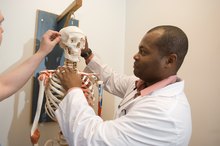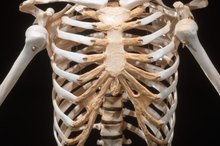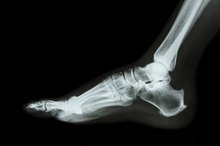The Male & Female Pelvic Differences
The pelvis is the bony structure of the hips, specialized to support the spine bones and to protect the abdominal organs. The pelvis consists of the three bones that make up the hips; the sacrum, a fusion of five separate sacral vertebrae; and the coccyx or tailbone, a fusion of four small vertebrae.
If you are experiencing serious medical symptoms, seek emergency treatment immediately.
Bone Structure
In general, the bones of men are “larger and more robust” than those of women, according to the Smithsonian National Museum of Natural History 1. In addition, male bones tend to be thicker at the sites where muscles attach. This is true of the pelvic bones, although the pelvis has additional sex-specific features that make it the best indicator of the sex of an unknown skeleton.
Bone Position
Male Vs. Female Skeleton
Learn More
The female pelvic bones encompass a broad flat space, and the angle of the male pelvic bones enclose a taller, more narrow space. The ilium is the broad, flaring crest on either side of the pelvis. When you put your hands on your hips, you feel the ilia. In men, the ilia tend to be taller and narrower, with the top ridges in a more vertical position; in women, the ilia are wider and flatter, flaring out at the sides. The ischia, the hip bones that we sit on, join in the front of the body at the pubic symphysis. The angle of ischia at the pubic symphysis is about 60 degrees in a male pelvis but closer to 90 degrees in a female, according to “Basic Human Anatomy.” In men, the coccyx, or tailbone, angles forward into the pelvic cavity to a greater extent than the female coccyx, according to Coocyx.org 34.
- The female pelvic bones encompass a broad flat space, and the angle of the male pelvic bones enclose a taller, more narrow space.
- The angle of ischia at the pubic symphysis is about 60 degrees in a male pelvis but closer to 90 degrees in a female, according to “Basic Human Anatomy.” In men, the coccyx, or tailbone, angles forward into the pelvic cavity to a greater extent than the female coccyx, according to Coocyx.org 3.
Pelvic Spaces
The hole in the male pelvis' ischium tends to be larger and rounded, compared to the smaller and more triangular shape in the female ischium. The pelvic cavity, the space bounded by the ischia and ilia, is open and circular in females but narrower and more heart-shaped in males. With the wider angle at the pubic symphysis and the smaller incursion of the tailbone, the outlet of the female pelvis is also larger and rounder.
Purpose
Range of Motion in Men Vs. Women
Learn More
The structure of the female pelvic bones and the spaces that they form are optimized to provide space for the growth and birth of a baby. In particular, the distance between the ischia and the inner diameter of the space they outline is larger in the female pelvis to accommodate the baby’s head during childbirth.
Pelvic Organs
The bony pelvis protects the abdominal organs. In females, the ovaries, Fallopian tubes and uterus all lie safely cradled within the boundaries of the pelvis. However in males, the testicles lie outside of the pelvis' protection, in the cooler environment of the scrotum that provides the optimum temperature for sperm production.
Related Articles
References
Writer Bio
In 20 years as a biologist, Susan T. McClure has contributed articles to scientific journals such as "Nature Genetics" and "American Journal of Physiology." She earned her Ph.D. from the University of Maryland. She enjoys educating people about science and the challenge of making complex information accessible.









